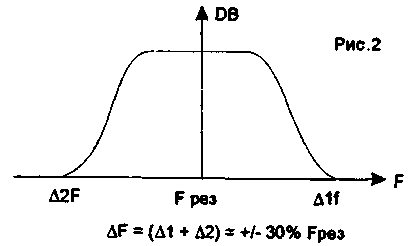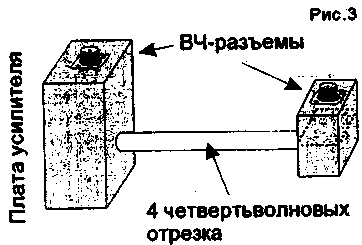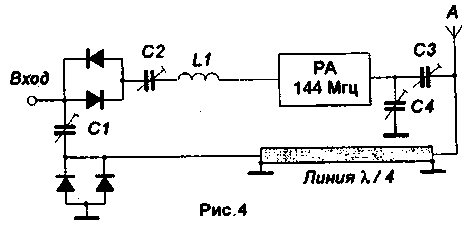Antenna switch for 144 MHz. Encyclopedia of radio electronics and electrical engineering

Encyclopedia of radio electronics and electrical engineering / VHF antennas
 Comments on the article
Comments on the article
It is known from the theory of long lines that a quarter-wave segment of a coaxial cable, short-circuited at the end, has an infinitely large resistance at the resonant frequency. Due to the lack of high-frequency coaxial relays, I have been using this property for a long time to switch the antenna amplifier, Fig. 1.

In the receive mode, the antenna amplifier and the relay windings are energized. Quarter-wave segments connected to the input and output of the amplifier are a continuation of the connecting cable and with Rin to Rout equal to the cable impedance, they do not affect the feeder parameters. Quarter-wave segments intended for "bypass", short-circuited segments from the side of the antenna and transceiver have a large resistance. Their amplitude-frequency characteristic (AFC) is shown in Fig.2.

Thus, in addition to purely insulating properties, they also have filtering properties, being a fairly effective filter with steep slopes due to the high quality factor at the resonant frequency.
In transmit mode, the power is removed from the amplifier, and its input and output are grounded, which provides an almost complete guarantee of protection against the penetration of the RF signal of the transmitter. In addition, the quarter-wave segments connected directly to the input and output of the antenna amplifier are notch filters for the transmitter, and the other two segments connected in series have a length of 0,5 lambda and have the property of a 1: 1 impedance transformer without affecting feeder parameters.
Any available relays can be used as switching relays. The main requirement for the relay is the smallest possible intercontact capacitance. Good results are obtained when using RES-34, RPV-2/7, etc. with output power up to 200 W.
The manufacturing option of the antenna switch is shown in Fig.3.

Four quarter-wave lengths of cable, 342 mm long for a frequency of 144,1 MHz, are placed in an dural tube 340 mm long and 30 mm in diameter. One end of the pipe is rolled into a small box with two high-frequency coaxial connectors (on the right in the figure), separated by a shield. The other end is rolled into a large box (on the left in the figure), in which there are two relays and a power amplifier board, Fig. 3. It is necessary to take into account the requirements for the installation of high-frequency devices and be sure to separate the input circuit from the output circuit with a screen.
On the same principle, based on the property of a quarter-wave segment, relayless switching of a 20-watt power amplifier installed in a car is carried out. Instead of high-frequency relays, diode switching is used - anti-parallel switching of KD503B silicon diodes, Fig. 4.

In the HF transmission mode, the transceiver signal opens the keys and the quarter-wave segment from the input side of the RA turns out to be short-circuited, and from the side of the antenna it has a large resistance. In the reception mode, the power of the signal coming from the antenna is not enough to open the keys and the signal through the quarter-wave segment passes unhindered to the input of the transceiver. With a very large signal, the diode switches perform a protective function.
The power amplifier is assembled on transistors KT925A and KT925V according to the scheme published in "R-D" No. 1-96.
100 mW is supplied to its input from a "manual" transceiver, and about 50 W is obtained at a load of 20 ohms. The amplifier works on a shortened quarter-wave magnetic antenna of the MW range with a partially cut off upper part - above the extension coil.
Author: S.Ksenofontov, ES4BW, Kohtla-Jarve; Publication: N. Bolshakov, rf.atnn.ru
 See other articles Section VHF antennas.
See other articles Section VHF antennas.
 Read and write useful comments on this article.
Read and write useful comments on this article.
<< Back
 Latest news of science and technology, new electronics:
Latest news of science and technology, new electronics:
A New Way to Control and Manipulate Optical Signals
05.05.2024
The modern world of science and technology is developing rapidly, and every day new methods and technologies appear that open up new prospects for us in various fields. One such innovation is the development by German scientists of a new way to control optical signals, which could lead to significant progress in the field of photonics. Recent research has allowed German scientists to create a tunable waveplate inside a fused silica waveguide. This method, based on the use of a liquid crystal layer, allows one to effectively change the polarization of light passing through a waveguide. This technological breakthrough opens up new prospects for the development of compact and efficient photonic devices capable of processing large volumes of data. The electro-optical control of polarization provided by the new method could provide the basis for a new class of integrated photonic devices. This opens up great opportunities for ... >>
Primium Seneca keyboard
05.05.2024
Keyboards are an integral part of our daily computer work. However, one of the main problems that users face is noise, especially in the case of premium models. But with the new Seneca keyboard from Norbauer & Co, that may change. Seneca is not just a keyboard, it is the result of five years of development work to create the ideal device. Every aspect of this keyboard, from acoustic properties to mechanical characteristics, has been carefully considered and balanced. One of the key features of Seneca is its silent stabilizers, which solve the noise problem common to many keyboards. In addition, the keyboard supports various key widths, making it convenient for any user. Although Seneca is not yet available for purchase, it is scheduled for release in late summer. Norbauer & Co's Seneca represents new standards in keyboard design. Her ... >>
The world's tallest astronomical observatory opened
04.05.2024
Exploring space and its mysteries is a task that attracts the attention of astronomers from all over the world. In the fresh air of the high mountains, far from city light pollution, the stars and planets reveal their secrets with greater clarity. A new page is opening in the history of astronomy with the opening of the world's highest astronomical observatory - the Atacama Observatory of the University of Tokyo. The Atacama Observatory, located at an altitude of 5640 meters above sea level, opens up new opportunities for astronomers in the study of space. This site has become the highest location for a ground-based telescope, providing researchers with a unique tool for studying infrared waves in the Universe. Although the high altitude location provides clearer skies and less interference from the atmosphere, building an observatory on a high mountain poses enormous difficulties and challenges. However, despite the difficulties, the new observatory opens up broad research prospects for astronomers. ... >>
 Random news from the Archive Random news from the Archive The secret of the strength of ancient Roman concrete
09.07.2017
Marie D. Jackson from the University of Utah, USA, and her colleagues from various American, Italian and Chinese scientific institutions have found the answer to the question why modern concrete, used everywhere, from roads to buildings to bridges, can fail in just 50 years, but thousands of years after the Roman Empire collapsed, its concrete structures are still standing. It turned out that the matter was in a special ingredient, which over time makes the material stronger, not weaker.
The scientists began their search with an ancient solution recipe, described by the Roman engineer Marcus Vitruvius in 30 BC. His instruction is to make a mixture of volcanic ash, lime and sea water, add crushed volcanic rocks to it and place it in a wooden mold, which should then be immersed again in sea water.
There are many references in history to the durability of Roman concrete, including a cryptic note written in 79 BC describing concrete exposed to seawater as "a single mass of stone, impregnable by the waves and growing stronger every day." What does it mean?
To find out, the researchers studied pits made in an ancient Roman harbor in the Gulf of Pozzuoli near Naples, Italy. When they analyzed the resulting material, it turned out that the seawater had dissolved components of the volcanic ash, allowing new binding minerals to form. Within a decade, a very rare hydrothermal mineral known as aluminium-tobermorite formed in the concrete. The very fact that it gives strength to concrete has long been known, it can be obtained in the laboratory - and it is very difficult to incorporate it into concrete.
The researchers found that when seawater percolates through the cement matrix, it reacts with volcanic ash and crystals to form Al-tobermorite and a porous mineral called phillipsite.
However, it is unlikely that humanity will receive more durable piers and breakwaters in the near future, because both of these minerals have been formed for centuries to strengthen concrete. So modern scientists will have to develop a technology for the production of a modern version of ancient Roman cement.
|
 Other interesting news:
Other interesting news:
▪ New programmable multi-channel 16-/14-bit ADCs
▪ Gamers make decisions faster and more accurately
▪ IHLP-6767DZ-11 - High Current Low Profile Inductors
▪ Electric generator runs on friction
▪ Bones grow from fish scales
 News feed of science and technology, new electronics
News feed of science and technology, new electronics
 Interesting materials of the Free Technical Library:
Interesting materials of the Free Technical Library:
▪ site section Electrician's tool. Article selection
▪ article A plague on both your houses! Popular expression
▪ article What are the Paralympic Games? Detailed answer
▪ article Woodruff fragrant. Legends, cultivation, methods of application
▪ article Zaponovy varnishes from nitrocellulose. Simple recipes and tips
▪ article The candle disappears and is in his pocket. Focus Secret
 Leave your comment on this article:
Leave your comment on this article:
 All languages of this page
All languages of this page
Home page | Library | Articles | Website map | Site Reviews

www.diagram.com.ua
2000-2024







 Arabic
Arabic Bengali
Bengali Chinese
Chinese English
English French
French German
German Hebrew
Hebrew Hindi
Hindi Italian
Italian Japanese
Japanese Korean
Korean Malay
Malay Polish
Polish Portuguese
Portuguese Spanish
Spanish Turkish
Turkish Ukrainian
Ukrainian Vietnamese
Vietnamese




 Leave your comment on this article:
Leave your comment on this article: